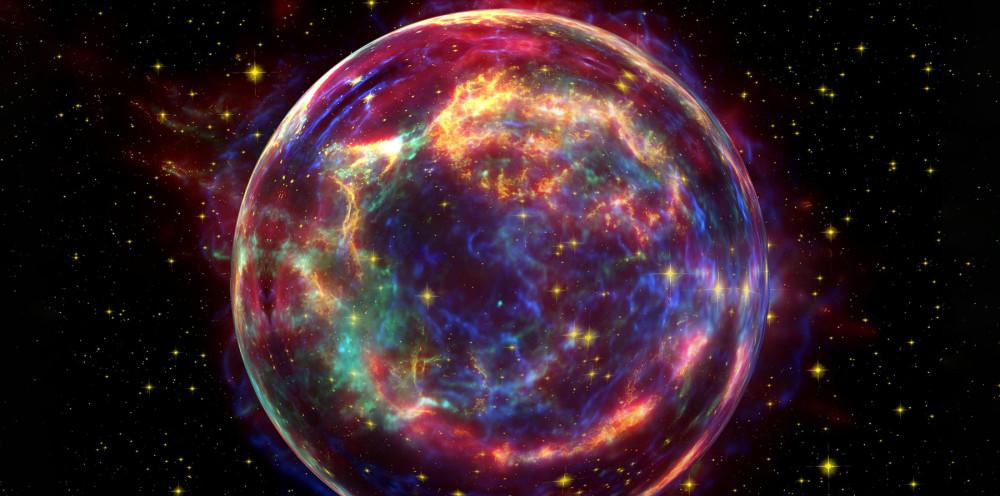About 14 million years ago, a series of supernova explosions created a giant bubble body about 1,000 light-years in diameter, and our solar system happened to be at the center of this bubble.
Doesn't that sound bizarre and funny? When I first saw this new study in the journal Nature, I felt that it was a new study that was not the same as what we had known in the past, and that it revealed the process of star formation in the universe in a new way, so what is this bubble like? Since this giant bubble was created by a supernova explosion, let's start with the supernova explosion. A supernova explosion is an extremely intense celestial activity that occurs at the end of the life of a massive star and releases an incomparably large amount of energy in an instant.

How did a supernova explosion happen?
Star is a kind of celestial body that can emit light and shine, and its light and heat all come from the fusion of hydrogen nuclei inside it, hydrogen elements form helium elements through fusion reactions under the action of high temperature and high pressure, but hydrogen elements will eventually be exhausted one day, when the fuel is insufficient, hydrogen fusion will weaken, and the outward radiation expansion pressure generated by fusion will also weaken, so under the action of core gravity, the internal pressure is further increased, so helium fusion is ignited, and the star is converted from the hydrogen fusion stage to the helium fusion stage. However, helium will eventually run out one day, so it will repeat the previous process, and the fusion reaction inside the star will advance step by step towards the heavier elements, and when the fusion reaction advances to the iron element, everything becomes different.
Before the iron element, the fusion of the element will release energy, and the fusion process of the iron element will absorb the energy, so the outward radiation expansion pressure generated by the fusion will completely disappear, so that all the matter will collapse sharply under the strong gravitational force of the center.
When all the matter hits the core, it triggers a rapid and strong rebound, so in an instant a huge amount of energy is released, which is a supernova explosion. How energetic is the supernova explosion? If a habitable planet exists within 50 light-years of the star in which the supernova erupts, its ecology will be completely destroyed. In addition to releasing enormous amounts of energy, supernova explosions also eject large amounts of stellar material that drift away with the shock waves generated by the explosion.
The universe is nearly vacuum, but it is not really a vacuum, and there are large amounts of gas and dust in the universe, which are distributed in space at a very low density.
When the shock wave generated by the supernova explosion hits, it will push the gas and dust in the universe together, so that at the edge of the shock wave, the density of matter gradually increases. A supernova explosion is like a bubble that spreads from the center to the surroundings, and when a series of supernova explosions occur, the bubbles will merge together to form a huge bubble, and at the edge of this giant bubble, the density of matter is extremely high, so that gas and dust begin to converge under the action of gravity, and eventually condense and collapse into a new star. A team of researchers led by astronomer Catherine Zucker used data visualization techniques to reconstruct a model of this bubble, in which a large number of known stars are located at the edge of this bubble, including the familiar heart of the second.
But our sun is not at the edge of this bubble, but at the center of this bubble.
It's a very interesting thing, and it leads us to a sense of "being the center of the universe." Of course, we know we're not going to be the center of the universe, so is it a coincidence? There are not so many coincidences in the universe, we have restored a bubble model through data visualization technology, and the result is that the solar system is exactly at the center of this bubble, if it is a coincidence, the probability of occurrence is too low. So there is only one reasonable explanation, that is, the bubble is universal in the universe, and the bubble we restore is only one of the countless bubbles in the universe.
The researchers call this bubble a "local bubble," and the sun wasn't at the center of the local bubble from the start, when in fact, a long time ago, the sun didn't belong to the bubble at all.
The sun is not stationary, it is orbiting the center of the Milky Way at a speed of 220 kilometers per second, in contrast, the local bubble is moving very slowly, from the model point of view, its movement speed is less than 2 kilometers per second, so the sun is through the movement to reach the center of the local bubble, and in the future its relative position with the local bubble will change. Studying the process of star formation is a key to understanding the universe, and further in-depth study of the evolution of local bubbles may reveal more mysteries about the universe in the future.